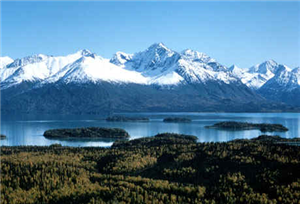Lake Clark National Park and Preserve | view more tourist attractions
Lake Clark National Park and Preserve is a United States National Park in southwestern Alaska. It was first proclaimed a national monument in 1978, then established as a national park and preserve in 1980 by the Alaska National Interest Lands Conservation Act. The park includes many streams and lakes vital to the Bristol Bay salmon fishery, including its namesake Lake Clark. A wide variety of recreational activities may be pursued in the park and preserve year-round. Located about 100 miles (160 km) southwest of Anchorage, the park includes a variety of features not found together in any of the other Alaska Parks: the junction of three mountain ranges, a coastline with rainforests along the Cook Inlet, a plateau with alpine tundra on the west, glaciers, glacial lakes, major salmon-bearing rivers, and two volcanoes, Mount Redoubt and Mount Iliamna. Redoubt is active, erupting in 1989 and 2009. The wide variety of ecosystems in the park mean that virtually all major Alaskan animals, terrestrial and marine, may be seen in and around the park. Salmon, particularity sockeye salmon, play a major role in the ecosystem and the local economy. The Kvichak River is the world's most productive watershed for sockeye salmon. Large populations of brown bears are attracted as a result, to feed on the spawning salmon in the Kijik River and at Silver Salmon Creek, and as a result bear viewing is a common activity in the park.
No roads lead to the park and it can only be reached by boat or small aircraft, typically floatplanes. The major settled area in the park is Port Alsworth on Lake Clark in the southwestern corner of the park. Five other settlements are within the park, populated mainly by Dena'ina natives. Prior to the park's establishment isolated cabins were scattered around the region, the most notable belonging to Richard Proenneke, whose films documenting his solitary life at Twin Lakes were made into Alone in the Wilderness in 2003.
Lake Clark was proclaimed a national monument by President Jimmy Carter using the Antiquities Act on December 1, 1978, Lake Clark's status was changed to national park and preserve in 1980 by Congress, and about two-thirds was designated wilderness. While both sport and subsistence hunting are permitted in the national preserve lands, only subsistence hunting by local residents is permitted within the National Park.
